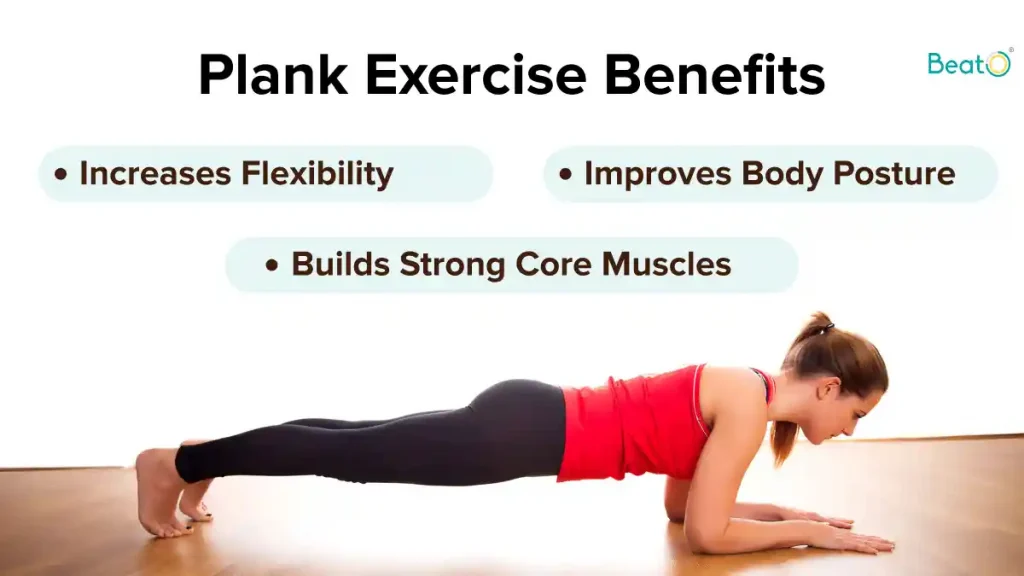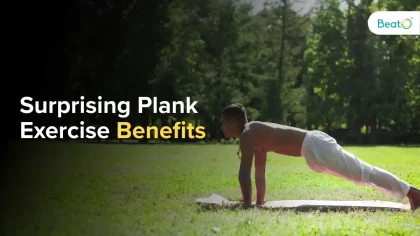The plank exercise benefits are known in fitness worldwide, known for its effectiveness in strengthening the core and improving overall stability. However, it’s not as simple as it looks. Doing it correctly requires concentration, proper form, understanding of common mistakes, and awareness of its various modifications. Here’s everything you need to know about planking:

Plank Exercise Benefits, The Power of Planking

The plank exercise benefits in improving posture, enhancing stability, and can even help reduce back pain. Remember, though, quality always trumps quantity. It’s better to hold a plank for 20 seconds with perfect form than a minute with poor form.
Also Read: How Sukhasana Can Revolutionise Your Life And Help Stay Focussed!
Let’s delve deeper into four of the most impactful advantages of doing planks:
Full Body Workout
Plank exercise benefits extend beyond just your core muscles, benefiting your entire body. When you hold a plank, you’re not just engaging your abdominal muscles, you’re also working your shoulders, arms, back, glutes, and legs. This is because maintaining the position requires a coordinated effort from multiple muscle groups. As such, planks can help develop whole-body strength and coordination, making them a highly efficient exercise for overall fitness.
Improved Posture
Regularly performing planks can significantly improve your posture. A strong core is essential for maintaining an upright position, whether you’re sitting, standing, or moving around. Planks strengthen the muscles that align the spine, promote a neutral posture, and help evenly distribute weight in the body. This can alleviate strain on the lower back, reduce the risk of injury, and even improve digestion and breathing.
Also Read:8 Astonishing Basil Seeds Benefits For Weight Loss
Increased Flexibility
While planks are known for their strength-building benefits, they also play a crucial role in enhancing flexibility. The exercise stretches and expands various muscle groups, including those around your shoulder blades, collarbone, and hamstrings, as well as the arches of your feet and toes. Increased flexibility can improve your performance in other exercises, reduce the risk of injuries, and make everyday movements like bending and twisting easier.
Enhanced Metabolic Rate
Planks are a type of isometric exercise, which involves contracting muscles against stationary resistance. This type of training is highly efficient at burning calories. Furthermore, due to the intensity of the exercise and the number of muscles engaged, your metabolism can remain elevated for hours after the workout, meaning you continue to burn calories at a higher rate, even when you’re resting. This makes planks an excellent exercise choice for anyone looking to lose weight or maintain a healthy body composition.
Also Read:Cultivating Balance: Exploring Trikonasana Benefits And Proper Technique To Do It!
How To Plank the Right Way
The traditional plank, also known as the forearm plank, involves positioning your body in a straight line from head to heels, resting on your forearms and toes. Here’s how to do it:
- Start in a push-up position: Begin by getting into a high push-up position with your palms flat on the floor and your hands shoulder-width apart.
- Lower onto your forearms: Bend your elbows to lower your body towards the floor, resting on your forearms with your elbows aligned directly under your shoulders.
- Keep your body straight: Your body should form a straight line from your head to your heels. Engage your abs, squeeze your glutes, and ensure that your hips don’t sag or lift.
- Hold this position: Keep your gaze down, neck relaxed, and hold this position for as long as you can maintain good form.
Also Read: Exploring The Benefits of Markarasana: How It Impacts Body and Mind
Variations of the Plank
Once you’ve mastered the traditional plank, challenge your core with these variations:
Side Plank
The side plank is a fantastic exercise to target the obliques – the muscles on the sides of your abdomen. To perform a side plank, start by lying on your right side with your legs straight. Prop your upper body up on your right elbow and forearm, which should be directly below your shoulder. Stack your left foot on top of your right, then lift your hips until your body forms a straight line from head to feet. Engage your core and try to hold this position for as long as you can. Remember to repeat on the other side!
This exercise not only strengthens your obliques but also challenges your balance, which can help improve your performance in other workouts and daily activities.
Reverse Plank
The reverse plank is an excellent way to work the posterior muscles of the body, including the glutes and hamstrings. To do a reverse plank, sit on the floor with your legs extended in front of you and your palms on the floor behind your hips, fingers pointing towards your feet. Press through your hands and heels to lift your body off the ground until it forms a straight line from head to heels. Keep your gaze upwards, and ensure that your hips are lifted and your core is engaged throughout the exercise.
This plank variation can help counteract the forward-leaning posture many of us adopt during daily activities like sitting at a desk, driving, etc.
Also Read:7 Incredible Bael Fruit Benefits For A Healthier You
Walking Plank
The walking plank adds a dynamic element to the traditional plank, working the upper body and core while improving coordination. Start in a high plank position with your hands directly under your shoulders and your body in a straight line from head to heels. Then, step your right hand and right foot to the right, followed by your left hand and left foot. Step back to the left with your left hand and left foot, followed by your right hand and right foot.
The walking plank is a more challenging variation that can help increase strength and stability in the upper body, core, and even the lower body.
Common Mistakes to Avoid While Doing a Plank
Even seasoned exercisers can make mistakes when planking. Get plank exercise benefits by avoiding these mistakes:
- Sagging hips: This is a sign of a weak core and can strain the lower back. Keep your body in a straight line to protect your spine.
- High hips: Lifting your hips too high takes the tension away from your core. Aim for a straight line from head to heels.
- Looking up or tucking the chin: Both positions can strain the neck. Keep your gaze down and your neck relaxed.
Also read:Manage Your Fitness With The Perfect Blend of Exercise & Supplements
Conclusion
In essence, plank exercise benefits can provide comprehensive fitness benefits, ranging from improved strength and posture to increased flexibility and metabolic rate. As with any exercise, it’s essential to focus on maintaining proper form to maximise these benefits and minimise the risk of injury.
Disclaimer: The content of this article is compiled information from generic and public sources. It is in no way a substitute, suggestion, or advice for a qualified medical opinion. Always consult a specialist or your own doctor for more information. Beato App does not claim responsibility for this information.
Are you looking for the perfect glucometer to check your blood sugar level? Try out BeatO smartglucometerkit, affordable and easy to use.
Discover top-tier diabetes care with BeatO’s Chief Clinical Officer,Dr. Navneet Agarwal. His expertise in Diabetes ensures personalised guidance for overall health. Try out a smartglucometerand keep track of blood sugar levels now.




